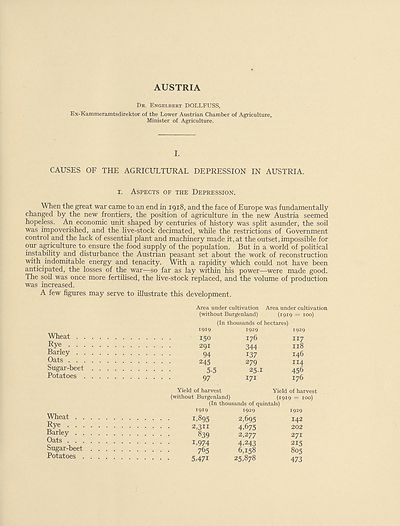Download files
Complete book:
Individual page:
Thumbnail gallery: Grid view | List view

AUSTRIA
Dr. Engelbert DOLLFUSS,
Ex-Kammeramtsdirektor of the Lower Austrian Chamber of Agriculture,
Minister of Agriculture.
I.
CAUSES OF THE AGRICULTURAL DEPRESSION IN AUSTRIA.
i. Aspects of the Depression.
When the great war came to an end in 1918, and the face of Europe was fundamentally
changed by the new frontiers, the position of agriculture in the new Austria seemed
hopeless. An economic unit shaped by centuries of history was split asunder, the soil
was impoverished, and the live-stock decimated, while the restrictions of Government
control and the lack of essential plant and machinery made it, at the outset, impossible for
our agriculture to ensure the food supply of the population. But in a world of political
instability and disturbance the Austrian peasant set about the work of reconstruction
with indomitable energy and tenacity. With a rapidity which could not have been
anticipated, the losses of the war—so far as lay within his power—were made good.
The soil was once more fertilised, the live-stock replaced, and the volume of production
was increased.
A few figures may serve to illustrate this development.
Wheat .
Rye . .
Barley .
Oats . . ,
Sugar-beet
Potatoes
Wheat . ,
Rye . .
Barley . ,
Oats . . ,
Sugar-beet
Potatoes .
Area under cultivation Area under cultivation
(without Burgenland) (1919 = 100)
(In thousands of hectares)
1919 1929 1929
150 176 117
291 344 Il8
94 137 146
245 279 114
5-5 25.1 456
97 171 176
Yield of harvest
(without Burgenland)
(In thousands of quintals)
Yield of harvest
(1919 = 100)
1919
1,895
2,3H
839
1,974
765
5,471
1929
2,695
4,675
2,277
4,243
6,158
25,878
1929
142
202
27I
215
805
473
Dr. Engelbert DOLLFUSS,
Ex-Kammeramtsdirektor of the Lower Austrian Chamber of Agriculture,
Minister of Agriculture.
I.
CAUSES OF THE AGRICULTURAL DEPRESSION IN AUSTRIA.
i. Aspects of the Depression.
When the great war came to an end in 1918, and the face of Europe was fundamentally
changed by the new frontiers, the position of agriculture in the new Austria seemed
hopeless. An economic unit shaped by centuries of history was split asunder, the soil
was impoverished, and the live-stock decimated, while the restrictions of Government
control and the lack of essential plant and machinery made it, at the outset, impossible for
our agriculture to ensure the food supply of the population. But in a world of political
instability and disturbance the Austrian peasant set about the work of reconstruction
with indomitable energy and tenacity. With a rapidity which could not have been
anticipated, the losses of the war—so far as lay within his power—were made good.
The soil was once more fertilised, the live-stock replaced, and the volume of production
was increased.
A few figures may serve to illustrate this development.
Wheat .
Rye . .
Barley .
Oats . . ,
Sugar-beet
Potatoes
Wheat . ,
Rye . .
Barley . ,
Oats . . ,
Sugar-beet
Potatoes .
Area under cultivation Area under cultivation
(without Burgenland) (1919 = 100)
(In thousands of hectares)
1919 1929 1929
150 176 117
291 344 Il8
94 137 146
245 279 114
5-5 25.1 456
97 171 176
Yield of harvest
(without Burgenland)
(In thousands of quintals)
Yield of harvest
(1919 = 100)
1919
1,895
2,3H
839
1,974
765
5,471
1929
2,695
4,675
2,277
4,243
6,158
25,878
1929
142
202
27I
215
805
473
Set display mode to:
![]() Universal Viewer |
Universal Viewer | ![]() Mirador |
Large image | Transcription
Mirador |
Large image | Transcription
Images and transcriptions on this page, including medium image downloads, may be used under the Creative Commons Attribution 4.0 International Licence unless otherwise stated. ![]()
| League of Nations > Economic and financial section > Agricultural crisis > Volume 1 > (93) |
|---|
| Permanent URL | https://digital.nls.uk/190903859 |
|---|
| Shelfmark | LN.II.2/2.(35) |
|---|---|
| Attribution and copyright: |
|
| Shelfmark | LN.II.2/2.(35-35) |
|---|---|
| Shelfmark | LN.II |
|---|
| Description | Over 1,200 documents from the non-political organs of the League of Nations that dealt with health, disarmament, economic and financial matters for the duration of the League (1919-1945). Also online are statistical bulletins, essential facts, and an overview of the League by the first Secretary General, Sir Eric Drummond. These items are part of the Official Publications collection at the National Library of Scotland. |
|---|---|
| Additional NLS resources: |
|

